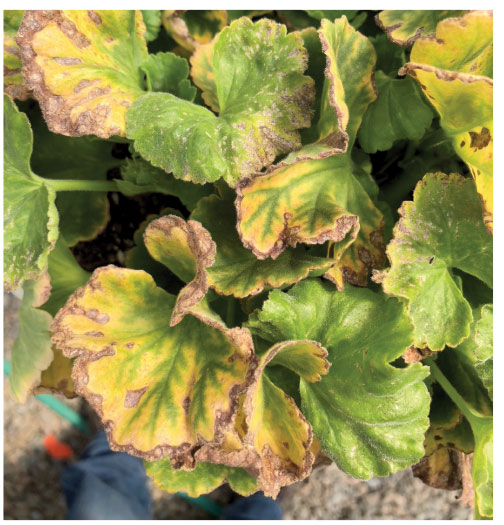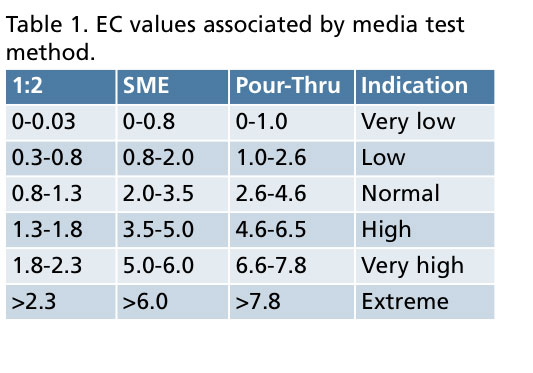5/1/2020
Plant Growth Media Testing: Always Well Worth It!
Joanne Lutz

You might only think of media testing as an inexpensive insurance policy for your valuable crops, but regular testing can head off nutritional problems before crops ever show any symptoms. Maintaining the ideal media pH goes a long way towards maximizing the nutritional health of crops.
The availability of micronutrients is especially dependent on media pH. With the exception of molybdenum, micronutrients are more available as media pH decreases with all other factors being equal. Crops such as calibrachoa, petunias and flowering vinca aren’t as efficient at taking up iron and benefit from a lower media pH range. A handful of other crops—such as seed and zonal geranium, African marigolds and pentas—are so efficient at taking up micronutrients that they need to be grown at a higher media pH to avoid toxicity from over-accumulating iron and manganese.
Pictured: A zonal geranium with low pH-induced micronutrient toxicity.
Monitoring the soluble salts (AKA electrical conductivity [EC]) gives growers a snapshot of the overall media fertility level. This information can help you assess your fertilizer program and may even help you spot injector performance problems or fertilizer mixing errors.
Media pH and EC can be reliably tracked through in-house testing and it doesn’t require expensive equipment or difficult testing procedures. Improvements in technology have led to more reliable and affordable “direct-stick” meters as well. There are several testing labs across the country that provide in-depth media testing that includes the amount of individual nutrients that can be used for regular monitoring and troubleshooting nutritional problems.
The three most common methods for in-house testing of media pH and EC are the 2:1 Technique, the Pour-Thru Method and the Saturated Media Extract (SME). A minimum of six to 10 samples is needed from a crop to give a representative sample. The person responsible for taking samples needs to be consistent from sample to sample. Keeping detailed records concerning sampling done before or after fertilization avoids significant differences in pH and EC readings.
 For the greatest accuracy, draw samples from an area approximately halfway down the root ball. The volume of media needed for sampling for 4-in. and larger pots is about a tablespoon per pot, or a pinch, in towards the center of the pot. Pool these samples together to make the collective sample. Fill the measuring cup at approximately the same level of compaction that’s found in the pots being tested. For plugs and smaller cells, the Squeeze Method, developed by NC State University, is recommended. Consult your supplier for details.
For the greatest accuracy, draw samples from an area approximately halfway down the root ball. The volume of media needed for sampling for 4-in. and larger pots is about a tablespoon per pot, or a pinch, in towards the center of the pot. Pool these samples together to make the collective sample. Fill the measuring cup at approximately the same level of compaction that’s found in the pots being tested. For plugs and smaller cells, the Squeeze Method, developed by NC State University, is recommended. Consult your supplier for details.
• 2:1 Technique: This method is quickly and easily done. The following materials are needed before sampling: distilled water, measuring cup, meter(s) that measure EC and pH, and a container made of glass or plastic. Two parts distilled water are mixed with one-part media—easy quantities to work with would be 1 cup of distilled water and ½ cup of media. Stir vigorously for a few minutes and then let it sit for one to four hours before taking your reading. Use meter(s) to test the water on the top after the particles settle out. If the meter used requires filtration, coffee filters or cheesecloth can be used. Clean equipment after use and store properly.
• Pour-Thru Method: This method has an advantage over the other methods in that no media needs to be collected. Irrigate the crop thoroughly to saturation and wait one hour before testing. Place a clean saucer under the pot to collect leachate. Distilled water needs to be applied to each pot to yield 50 ml (1.7 oz.) of leachate. A chart is available on the North Carolina State University Floricul-ture website (horticulture.ces.ncsu.edu) to determine the amount of water needed to obtain the 50 ml of extract for different container sizes. Collect the leachate, 50 ml, for your readings. Using your calibrated meter, test extracts within two hours, as the pH reading can change over time.
• Saturated Media Extract Method: This method is more accurate because it provides a more exact representation of field conditions, but is more time-consuming. Media samples are collected and put into a glass or plastic container. Slowly stir in distilled water until the media takes on a paste consistency with a little moisture glistening on the surface. Let stand for 60 minutes. Filter and then use your meter(s) to test the leachate for pH and EC.
When comparing test results performed by a commercial lab that uses an SME method, comparable 2:1 test results will be one half to one third of those reported by the lab. Prepared by Dr. Douglas Cox at the University of Massachusetts, Table 1 compares EC results from three methods of media testing. GT
Joanne Lutz is a GGSPro Technical Specialist for Griffin Greenhouse Supplies. She can be reached at ggsprotech@griffinmail.com.